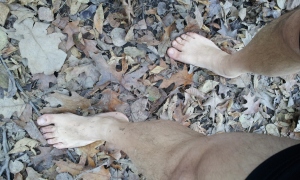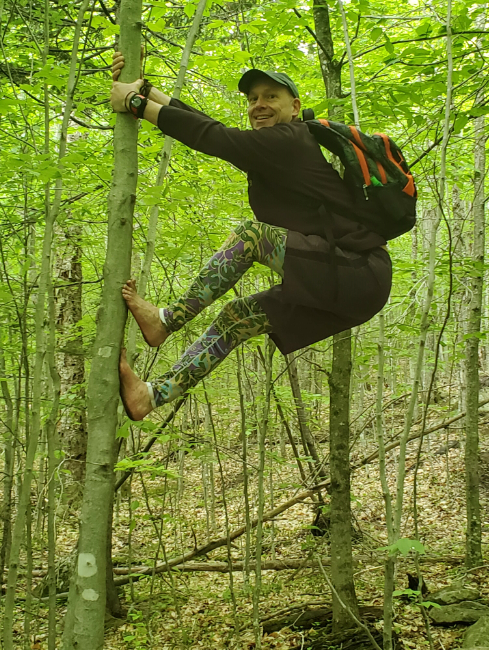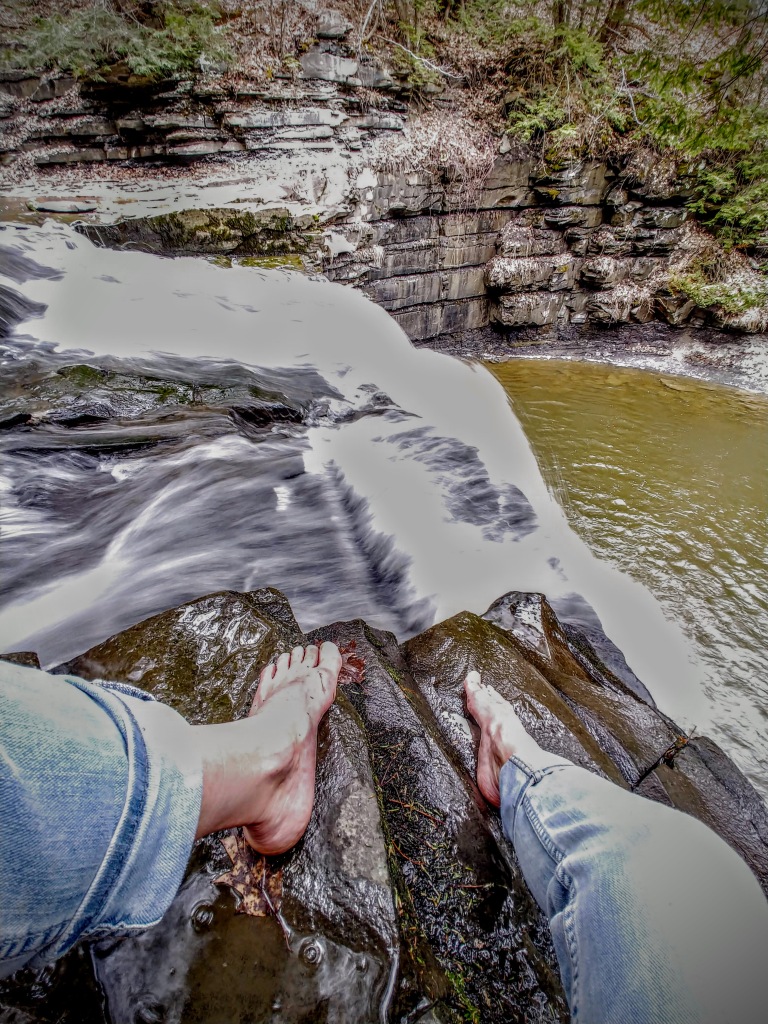Barefoot hiking enhances the hiking experience. To touch the earth with every step gives a sense of continuity, connectedness and energy.
For more information, read my article on barefoot hiking: The Art and Sole of Barefoot Hiking

You may be wondering “why hike barefoot, aren’t there a lot of dangers and inconveniences?”
There are some dangers, most of them human made: glass is the biggest, metal, or other waste. Sharp roots or rocks are natures dangers. Also, bees or other stinging/biting insects, poisonous snakes and in some parts of the world, strange parasites living in the water which burrow into the bloodstream through the skin! I don’t think we have to worry about that too much in the northern parts of North America though. These are things you just have to watch out for and be aware of.
The seasoned barefoot hiker remains aware of the path without consciously making a point to do so. It becomes natural, almost instinctive to avoid the occasional hazards of the trail.
For the newcomer, it requires some attention at first, and knowledge of the location. For instance, it is good to hike barefoot on well known trails initially. Choose trails which are already known to be relatively smoothed over.
The Society for Barefoot Living homepage is an excellent place to find out more about barefoot hiking as well as being barefoot as a part of everyday life! I barefoot all around myself, though I’m not yet at 100% like some people! Also, living in the great Northeast, winters get in the way of any serious all-the-time barefooting. But spring, summer and fall, it’s as if I can’t wear shoes. Maybe it’s an allergy. Some people are very serious about being barefoot and go without shoes all the time. The site has great information on non-existent laws and bogus regulations on walking around town, driving and working barefoot.
The Benefits
1. Minimal impact upon the earth (as opposed to hiking boots).
2. A sense of connection with the earth that can be very spiritual.
3. A natural contoured grip of foot to ground. You know the ground you are stepping on and step appropriately with the right pressure, angle, surface, etc. to gain the traction you need. It becomes automatic quite early to most people.
4. Adds touch to the senses used when hiking, which include sight, smell and sound. You can feel and instantly identify the cool moist or hot dry ground, mud, rocks, leaves, grass, etc. It adds a whole dimension to the experience.
5. Strengthens the feet, toughens the soles of the feet.
6. Can actually reduce the occurrence of blisters. Also, feet are not confined so they do not get overheated, sweaty and, how shall I say, malodorous.
7. Gives lightness of step. Fleet-footed. Can easily hop, jump, walk, balance.
If you are new consider some of the following points:
1. You may have sore feet after your first hike. I don’t mean because of something you may step on… I mean because of the bending and twisting of the foot. You should build up gradually, so as to allow your feet to strengthen. Allow your feet to grow into their new range of motion.
2. You should bring a first aid kit with you even on short hikes. I’ve needed mine once so far after many hikes (a sharp root got me when I jumped on it without looking first).
3. Have a plan in case you encounter particularly difficult terrain. I usually have a pair of hiking sandals in my pack if I am going into unknown trails.
4. Barefoot hiking in particularly hot or cold weather requires special attention. Hiking in the woods on a hot day is refreshing. But in the desert it might be downright painful. The cold can also be a challenge. The thicker the sole, the better you will fare in either of these settings.
5. Go with other unshod hikers. This helps to give confidence and hiking with others makes hiking with or without shoes safer.
6. Exercise your feet to help strengthen them. Do “toe-ups” on a stair. Stretch your legs often, and before your hike.
7. The newer you are, and the more vulnerable your feet are, the more you may find yourself looking down. This will get better as you become more experienced and as you gain confidence in you ability to walk the woods barefoot.
8. Treat your feet well after a hike with oils or moisturizers, especially in cold weather. This helps to keep the soles from drying out and cracking.
9. If you have known foot problems, contact your podiatrist or physician before venturing out barefoot.
10. Keep a journal of your barefoot hiking experiences!
Post a comment or send me an email note of your experience… good or bad!
Not ready to go barefoot yet?
Is there footwear which encourages the natural operation of the feet? Check this site’s info on minimal footwear brands for a full list of minimalist footwear. Or check here to read about benefits of barefoot shoes.
Future topics to be explored:
Should children hike barefoot?
Can I hike barefoot with a heavy backpack?
What do the experts say?
The natural history of barefoot hiking… native Americans and other indiginous people.


